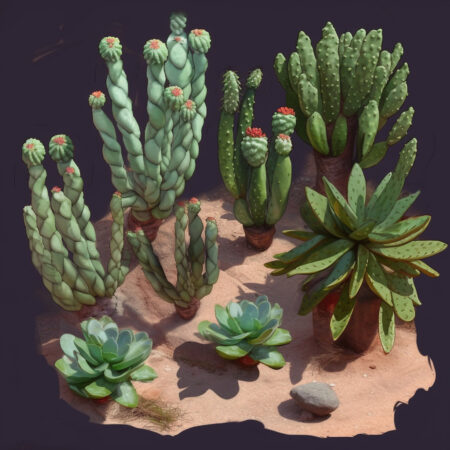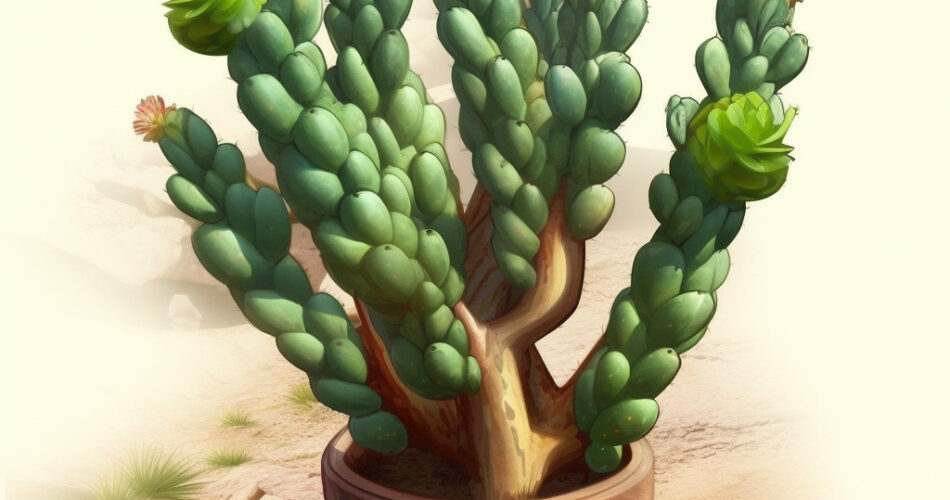Key Insights:
- “Pebble cacti” is another name for these unique plants, known for their distinct appearance and eye-catching flowers.
- These plants are indigenous to parts of South America, including regions within Argentina, Bolivia, and Paraguay.
- Different species come with varying growth habits, sizes, and care nuances; choose the one that fits your preference and environment.
- Bright, indirect sunlight, combined with a well-aerated soil mix, helps these plants flourish.
- It’s essential to water them only when the soil dries out completely, and they are best kept away from overly humid areas.
- They don’t need frequent fertilization and can be easily multiplied through stem segments.
- During cooler months, limit water intake and shield them from chilly winds and frosty conditions.
- Their unique appearance makes them perfect for various design ideas, whether in drought-tolerant landscapes, glass terrariums, or decorative pots.
Introduction to Tephrocactus Plants
Tephrocactus plants are a unique and fascinating addition to any garden or indoor space. With their striking appearance and resilience, these cacti are popular among succulent enthusiasts and collectors. Tephrocactus plants, also known as “pebble cacti,” belong to the Cactaceae family and are native to South America, specifically Argentina, Bolivia, and Paraguay. In this comprehensive guide, we will explore the various aspects of growing and caring for your plants.
What Makes Tephrocactus Plants Unique?
What sets Tephrocactus plants apart from other cacti species is their distinct pebble-like appearance. Their small, rounded stems are covered in clusters of tiny tubercles or bumps, resembling the texture of pebbles. This unique feature gives them their common name, pebble cacti. Tephrocactus plants also produce stunning flowers in various colors, adding to their allure and visual appeal.
The History and Origins of Tephrocactus
The Tephrocactus genus was first described by botanist Nathaniel Britton in 1909. These cacti are native to the high elevations of the Andes Mountains in South America. They have adapted to survive in harsh arid conditions and are known for their ability to withstand extreme temperatures and limited water availability. Over time, these plants have gained popularity among cactus enthusiasts worldwide.

Choosing the Perfect Tephrocactus Variety for Your Garden
When selecting Tephrocactus plants for your garden or indoor collection, it’s important to consider the various species available and their unique characteristics. Here are some factors to keep in mind:
Exploring the Different Tephrocactus Species
Tephrocactus plants come in a variety of species, each with its own distinct traits and growth habits. Some popular species include Tephrocactus articulatus, Tephrocactus burchardii, Tephrocactus geometricus, Tephrocactus molinensis, and Tephrocactus weberi. These species differ in their stem colors, tubercle formation, and flower colors, allowing for a diverse range of options to choose from.
Factors to Consider When Selecting The Right Cactus
When choosing Tephrocactus cacti, consider the growth habits, size, and care requirements of each species. Some species are more compact and suitable for smaller spaces, while others can grow larger and require more room. Additionally, take into account the natural climate and conditions the specific species are adapted to, ensuring compatibility with your local environment.
Creating the Ideal Growing Environment for Tephrocactus Cactus
To successfully cultivate Tephrocactus plants, it’s essential to provide them with the ideal growing environment. Pay attention to the following factors:
Understanding the Light Requirements for This Cactus
Tephrocactus plants thrive in bright, indirect light. They should be placed near a window or in a location where they can receive several hours of sunlight each day. However, too much direct sunlight can cause sunburn and damage to the plant. It’s important to strike a balance and monitor the light conditions regularly.
The Best Soil Mix
Tephrocactus plants require well-draining soil to prevent waterlogged roots and rot. A recommended soil mix for these cacti consists of a combination of regular potting soil, perlite, and coarse sand. This mixture allows for proper drainage while retaining some moisture to support healthy root growth.
Watering and Humidity Needs
Tephrocactus plants are adapted to dry conditions and have low water requirements. It’s crucial not to overwater them, as this can lead to root rot and other issues. Allow the soil to dry out completely between waterings and reduce watering during the winter months when the plants enter a period of dormancy. Additionally, avoid high humidity environments, as excessive moisture can be detrimental to the health of this cacti.
Essential Care Tips for Healthy Tephrocactus Plants
To ensure the longevity and vitality of your Tephrocactus plants, follow these care tips:
Feeding and Fertilizing
Tephrocactus plants have relatively low nutritional requirements and do not require frequent fertilization. During the growing season, a diluted cactus fertilizer can be applied once a month to provide essential nutrients. However, it’s important to follow the instructions on the fertilizer packaging and avoid overfertilization, as this can cause adverse effects.
Pruning and Propagating
Pruning is not commonly necessary for Tephrocactus plants unless there are damaged or diseased parts that need to be removed. However, propagating these cacti can be a rewarding experience. This cactus can be propagated through stem cuttings. Simply cut a healthy stem segment and allow it to callus for a few days before planting it in a well-draining soil mix. With proper care, the cutting will develop roots and grow into a new plant.
Dealing with Common Pests and Diseases
Tephrocactus plants are generally resilient and not prone to frequent pest infestations or diseases. However, they can occasionally attract common succulent pests such as mealybugs or scale insects. Inspect the plants regularly and treat any infestations promptly. Using a diluted neem oil solution or wiping the affected areas with alcohol-soaked cotton balls can effectively control these pests.
Overwintering Tephrocactus Cactus
As winter approaches, it’s essential to prepare your Tephrocactus plants for the dormant period. Follow these steps to ensure their survival:
Preparing This Cacti for Winter Dormancy
Tephrocactus plants naturally go dormant during the winter months. To prepare them for this period, gradually reduce watering in the fall. This helps the plants enter a state of dormancy and prevents water-related issues during the colder months. It’s also advisable to avoid fertilizing the plants during this time.
Protecting It from Cold and Frost
Tephrocactus plants are generally cold hardy but may require protection in extremely cold climates. If you live in an area with severe winters, it’s advisable to move the plants indoors or provide them with temporary shelter. Protecting this cactus from frost is crucial, as exposure to freezing temperatures can damage or kill the plants.
Monitoring for Signs of Winter Stress and Care
During the winter months, it’s important to monitor the condition of your Tephrocactus plants for signs of stress. Check for excessive shrinkage or discoloration, which may indicate dehydration. If necessary, provide a small amount of water to prevent severe dehydration, taking care not to overwater.
Tephrocactus Plant Collection and Display Ideas
Tephrocactus plants can be showcased in various creative and visually appealing ways. Here are some ideas for displaying your collection:
Creating Stunning Tephrocactus Arrangements
Combine different cactus species with contrasting colors and shapes to create visually striking arrangements. Plant them together in a shallow dish or use individual containers for each plant. Consider incorporating other succulents or decorative elements like rocks and driftwood to enhance the overall aesthetic.
Using Tephrocactus in Xeriscaping and Succulent Gardens
Tephrocactus cactuses are excellent additions to xeriscaping and succulent gardens, thanks to their drought tolerance and unique appearance. Plant them alongside other desert-adapted plants like Agave and Echinocactus to create a stunning and low-maintenance landscape. Ensure that the soil conditions and watering schedule align with the needs of all the plants in the garden.
Showcasing Tephrocactus Plants in Terrariums and Containers
Tephrocactus plants can also thrive in terrariums or containers, making them ideal for indoor display. Choose a glass container with good airflow and drainage, and fill it with a well-draining soil mix suitable for cacti. Arrange the cactuses creatively with other miniature succulents and decorative elements to create an eye-catching display.
By following the comprehensive guide provided above, you can cultivate and care for Tephrocactus successfully. Remember to tailor the specific instructions to the unique needs of your chosen species and monitor their growth and well-being regularly. With proper care and attention, these fascinating cacti will thrive and bring beauty to your garden or indoor space for years to come.
FAQ
Question: What sets these plants apart from others?
Answer: Their remarkable pebble-like appearance with clusters of tiny tubercles gives them a distinct look, leading to the nickname, “pebble cacti”. Additionally, they bloom beautiful flowers in a range of colors.
Question: Where do these unique plants originate from?
Answer: Native to high elevations of the Andes Mountains in South America, they’ve evolved to endure tough desert conditions, extreme temperatures, and limited moisture.
Question: How should I pick the right variety for my garden?
Answer: Research various species and their individual traits, such as growth patterns and size. Also, understanding the species’ natural environment helps in ensuring it aligns with your local conditions.
Question: What conditions do these plants prefer?
Answer: They flourish best in areas with bright but indirect sunlight and require a soil mix that drains quickly. Watering should be infrequent, and it’s best to ensure the soil dries completely between sessions. They also prefer less humid conditions.
Question: How do I maintain these plants?
Answer: They typically don’t need regular fertilization. While pruning isn’t essential, propagation is possible through stem segments. It’s also a good idea to check them periodically for pests or diseases. When colder seasons approach, lessen the watering frequency and shield them from frost.
Question: How should they be cared for during colder months?
Answer: As winter approaches, cut back on watering and refrain from adding any fertilizer. In particularly cold regions, you might consider relocating the plants indoors or offering a temporary cover. Throughout winter, keep an eye out for any signs of stress or dehydration.
Question: What are some display ideas for my collection?
Answer: These plants make a statement in diverse arrangements, whether they’re part of a drought-tolerant landscape or featured in a glass terrarium. Mixing species with varied colors and forms can produce particularly captivating displays. Additionally, they adapt well to indoor settings, especially in containers that provide adequate ventilation and drainage.
Question: How can I ensure their growth and vitality?
Answer: Adhere to the detailed guidance outlined above, adapting any general care instructions to the specific needs of your selected species. With consistent attention and care, these plants will not only survive but also thrive, enhancing the aesthetics of your space.




Comments